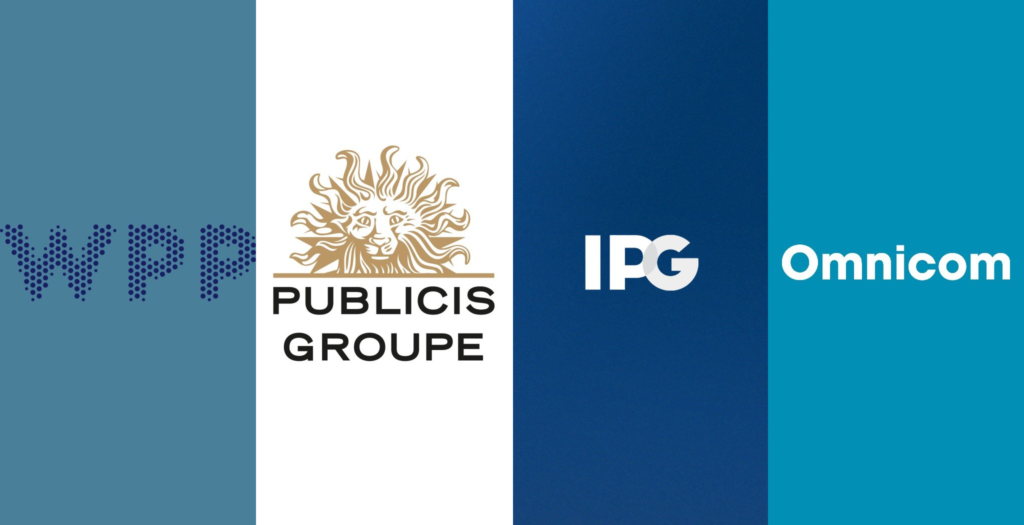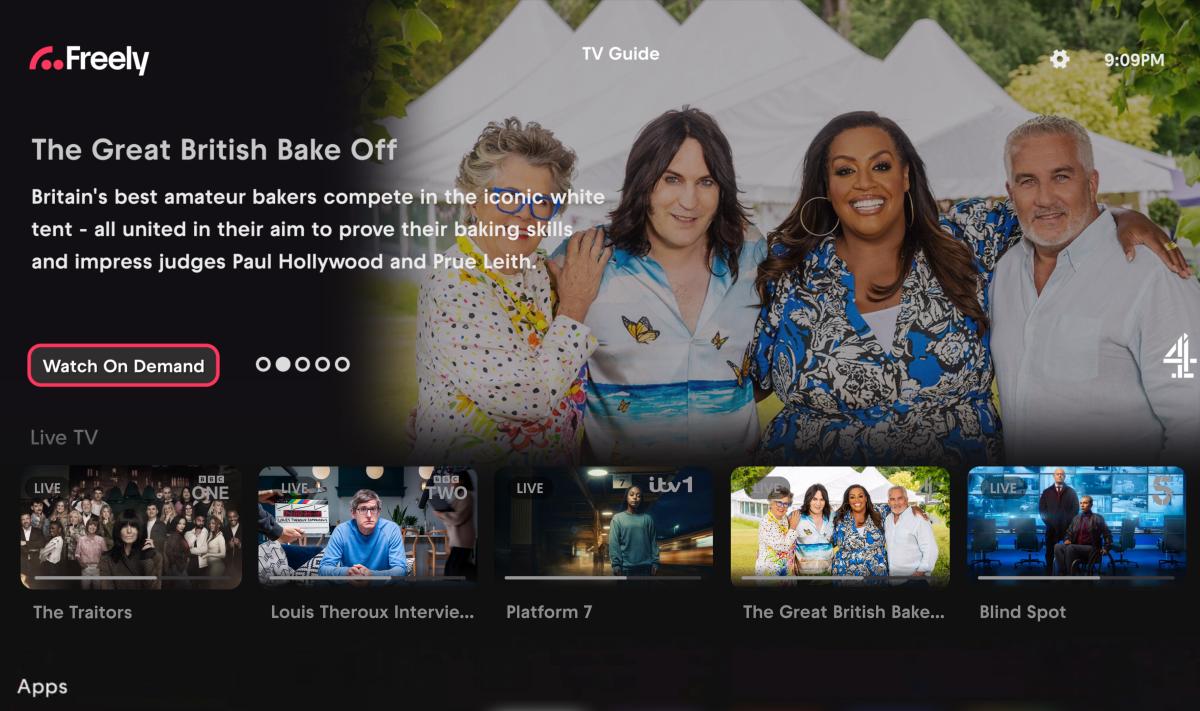Following the depths of the pandemic, the big four agency holding groups’ (WPP, Publicis Groupe, Interpublic Group, and Omnicom Group) quarterly financial results generally made for happy reading. Low revenues in 2020 meant that from Q2 2021 onwards, organic revenue growth was high across the board. This was to be expected given the low base set by 2020. But despite 2022 presenting its own series of macroeconomic challenges, growth continued, and agency CEOs kept an upbeat tone while projecting into 2023.
In the most recent set of financial results however, we’ve seen real divergence in how each of the agency groups are performing. There have been common themes and trends which have affected all of the big four, but different geographic and client mixes have meant that the impacts of these trends haven’t landed evenly.
And looking ahead, there are some obvious shared themes in the big four’s earnings reports and the accompanying earnings calls – with AI unsurprisingly featuring heavily across all four companies. But again, there are real differences in how each holding group views the AI opportunity, and where they see it being implemented across their businesses.
Here’s our breakdown of how the big four fared in Q2.
The end of universal growth
As mentioned earlier, the story in recent quarters for agency groups has been one of universal organic year-on-year growth. This changed in the first quarter of this year, when IPG posted -0.2 percent year-on-year growth, a very minor fall. Now in Q2, this variation has become even more pronounced.
IPG has once again posted negative organic growth (which it reports as organic change in net revenues), which has deepened to -1.7 percent. Publicis Group, which has generally been the top performer in recent quarters, sat on the other end of the spectrum with 7.1 percent organic growth year-on-year. Omnicom meanwhile reported organic growth of 3.4 percent, and WPP (which reports it as like-for-like revenues less passthrough costs) posted 1.3 percent growth.
It’s useful to look at last year’s results to get a sense of the comparables. IPG reported the slowest growth last year too, at 7.9 percent. But the four were all relatively close together – WPP, Publicis, and Omnicom reported 8.3 percent, 10.3 percent, and 11.3 percent growth respectively.
Mixed results in the US and Europe
Variations in agency groups results sometimes come down to their strengths in specific markets, and the states of the ad industries in those markets. In the most recent quarter however, the agency groups have reported quite different fortunes in major Western markets.
In the US for example, Publicis and Omnicom posted organic revenue growth of 4.9 percent and 2.4 percent respectively. WPP and IPG meanwhile both reported falls. WPP (which only reported country-specific organic changes for H1 as a whole, rather than Q2 specifically) posted a 4.5 percent drop, while IPG’s US revenues were down 2.5 percent.
Europe was also a mixed bag. All the holding groups saw growth in the UK. In order of strength: Publicis posted 17 percent organic growth, WPP reported 9 percent, Omnicom reported 2.5 percent, and IPG reported 1.7 percent. But fortunes varied elsewhere in Europe. Across Europe as a whole Publicis saw the highest growth rate, sitting at 15.2 percent. IPG meanwhile posted a 4.3 percent drop in organic net revenues in Continental Europe.
In fact outside of the UK, LATAM was the only region IPG gave a figure for which saw growth, up by 6.3 percent. Omnicom and Publicis also saw growth here, of 6.9 percent and 5.9 percent respectively (WPP didn’t give a figure for the region).
Results from China were also noteworthy. Last year, continued lockdowns and COVID restrictions produced falls in organic revenues for the holding groups. While revenues haven’t fully recovered, the two agency groups which gave numbers for China specifically both posted growth: 4.8 percent for WPP and 7 percent for Publicis.
Media delivers revenue growth, creative less so
Looking at each agency group’s business sectors, media was generally a strong point across the board.
WPP’s GroupM posted 6.1 growth in like-for-like revenues less passthrough costs in H1 (again, WPP didn’t give a figure for Q2 specifically). This propped up weaker performance from its creative agencies. Excluding GroupM, WPP’s global integrated agencies sector was down by 2.3 percent in H1.
Within media, WPP said that programmatic and connected TV both helped power double digit growth within GroupM Nexus. And GroupM is approaching a significant milestone, as digital now accounts for 49 percent of all media billings at WPP.
Publicis posted double-digit organic growth in media in Q2 – no specific figure was given. Publicis reports three business segments: Data & Tech (which saw single digit growth), Creative (which saw low single digit growth), and Media. The group says that each of these now accounts for one third of total revenues. Publicis credited this balance as key to its strong overall performance.
Omnicom reports four segments: Advertising & Media, Experiential, Precision Marketing, and Commerce and Brand Consulting. Experiential came in strongest at 9.2 percent, followed by Advertising & Media at 5.1 percent organic growth. Precision Marketing and Commerce and Brand Consulting were up by 2.3 percent and 2.4 percent respectively.
For IPG, Specialised Communications and Experiential was the only business segment which saw growth, up 3.7 percent. Media, Data, & Engagement Solutions was down by 1.5 percent, though CEO Philippe Krakowsky said on the earnings call that its media offering specifically had seen “strong growth”. Integrated Advertising and Creativity Led Solution, IPG’s third segment, was down by 3.8 percent.
Tech and retail clients hold back spending
Perhaps the most widely reported takeaway from the agency groups’ Q2 results was the impact of low spending from tech and telco clients, which was universally cited as a weak point.
IPG’s CEO Philippe Krakowsky said that the tech and telco sectors were “significant outliers” in terms of spend, stating that falls in spending from these clients weighed “significantly” on overall growth. IPG didn’t put a figure on this drop, but Krakowsky estimated that while a year ago tech clients would have accounted for around 15 percent of net revenues, they accounted for around 12 percent in Q2.
Outside of tech and telcos, Krakowsky said that the retail sector “decreased modestly against very strong multi-year comparable performance”. Every other client sector mentioned by Krakowsky saw growth, with automotive and financial services picked out as the strongest.
It was a similar story elsewhere. WPP saw a 4.9 percent drop in revenues from tech and digital clients across H1, while TMT (telecom, media and entertainment) revenues were down 1.4 percent and retail was down 7.9 percent. CEO Mark Read said that the decline in tech spending hit WPP particularly hard, as tech companies account for around 18 percent of WPP’s revenues.
CPG client spend at WPP meanwhile was up by 15.1 percent in H1, and financial services grew by 10 percent.
Omnicom reports changes in each client sector as a percentage of its overall revenues, rather than the percentage growth of each segment. Again, tech saw the biggest change, down from 12 percent of overall revenues to 8 percent. Telco revenues were also down from five to four percent. Auto meanwhile rose from ten to 12 percent, the highest growth of any segment for Omnicom.
And Publicis too, despite its strong overall growth, saw a fall in TMT revenues, which were down three percent organically. The French group reported growth in every other segment, with public sector, food and beverage, and leisure and travel coming in strongest at 26 percent, 20 percent, and 13 percent growth respectively.
And in contrast to WPP and IPG, Publicis saw strong growth in retail client spend, which was up by 11 percent.
AI central to strategy
Turning to the holding groups’ strategic priorities, AI was featured across the board. This of course has been the case in hundreds of businesses’ Q2 results in a multitude of industries, perhaps sometimes spuriously. But the agency groups were keen to stress that they’re not just artificially inserting artificial intelligence into their businesses, outlining how it’s currently being used, and where it’s likely to play a role in the future.
There’s a lot to unpack here, so we’ve broken it down group by group:
- Publicis
Publicis CEO Arthur Sadoun said that AI “is already at the core of [Publicis’] business model”. Publicis Sapient, Publicis’ digital transformation business, is a key cog here. Sadoun said that Sapient can develop AI tools and applications for both Publicis’ brand clients and Publicis itself. This is helping speed up creative processes, both in how Publicis markets itself to its clients, and in the production of assets for its clients. On the creativity front, Sadoun pointed to automation of translation, compliance, and asset reuse as key use cases.
“Having Sapient at the core of our business, not a partnership, not a couple of people that you hire, not small companies that you take on […] makes a very, very big difference,” said Sadoun.
Sadoun also pointed to Marcel, Publicis’ AI driven tool used across the business to foster collaboration and bring together talent from across agencies to work on different projects, as an area where AI already plays a role. And he said it’s increasingly important on the media front too. Sadoun said that Publicis-owned data unit Epsilon already uses AI to tie media investments to business outcomes, and power real time personalisation. This, he says, is another advantage. In the current climate, media owners are looking for efficiency, rather than flashy AI use cases. And AI-driven media optimisations help deliver this efficiency.
- Omnicom
While Sadoun was somewhat disparaging about AI partnerships, Omnicom CEO and chairman John Wren positioned them as a strength. He highlighted Omnicom’s AI and data-focused deals with the likes of Adobe, Amazon, Criteo, Infosum, Uber, and Microsoft.
But Wren added that these deals themselves are enhanced by Omni, Omnicom’s group-wide “operating system”. That, according to Wren, is where Omnicom’s real AI advantage lies. “Today, more than 50,000 people use [Omni] in over 100 countries, and it houses over one billion IDs globally with data from first, second and third parties,” said Wren. “Generative AI will turbocharge Omni users by helping them harness, deploy and activate this rich set of data. The open architecture of Omni makes it feasible for us to quickly adopt generative AI models from our key tech partners in a scalable, reliable and secure environment.”
Wren said he does see AI opportunities around creativity, but – like Sadoun – sees a big role for AI in driving efficiency. “Many of the products that were embedding [AI into] are really driving efficiencies,” he said. “And we’ll be creating APIs for CRM, for commerce, for PR, across the board.”
- WPP
WPP’s Mark Read seemed to put more focus on AI’s role in creativity than Sadoun or Wren. Read listed AI as one of five major client priorities (alongside investment behind brands, creativity and effectiveness, simplicity and transformation, and technology and data). He shared examples of how AI has already been using generative AI within its creative, and to power ad personalisation at scale. “We’re really bringing this type of technology used to create Hollywood movies to the advertising business,” said Read. “It solves a number of issues facing our clients and we’re starting to use that to produce work for clients”. He highlighted the importance of WPP’s AI-based partnership with NVIDIA for enabling this type of work.
But he did pick out media optimisation as a third area where AI can add a lot of value, stating that this is particularly relevant as a solution to the increasingly fragmented and complex media landscape.
Read was asked by one analyst on WPP’s earnings call whether the agency group has its own Marcel-like system. He answered that “we do have systems in each of our businesses that help us identify staff,” and that “we are using AI to pull staff from our systems to put on projects”.
- IPG
Interpublic Group, like the others, emphasised that it has already been using AI tools across its agencies for a good few years. At the moment, its biggest role is in data and media performance. And CEO Philippe Krakowsky said the company will be increasingly baking AI into its tools related to data, media, and performance media specifically.
IPG is also starting to use generative AI for content personalisation. Krakowsky said in the commerce space in particular, it’s playing a role in personalising content at scale, providing user support and product recommendations, and harnessing data to inform creative campaigns.
And while generative AI isn’t yet really generating initial ideas for creative campaigns, Krakowsky said it will soon “begin to have an impact on our industry as a catalyst for creativity”.
It was notable that Krakowsky struck a bit of a different tone from the other CEOs. Instead of claiming a unique competitive advantage around AI, he acknowledged that “every competitor will have access to these same kinds of tools”. As a result, Krakowsky believes it will remain important to hire the best creative talent, capable of making the most out of AI’s creative suggestions, in order to beat out competitors.
Two forecasts up, two forecasts down
The mixed overall results were represented in mixed forecasts for the year ahead.
Publicis and Omnicom both raised their full year guidance for 2023. Publicis increased its expectations to five percent organic growth, while Omnicom upped its guidance to a range of 3.5-5.0 percent (from 3.0-5.0 percent).
WPP and IPG meanwhile both lowered their forecasts. WPP now expects 1.5-3.0 percent organic growth across 2023 (compared with its previous projection of 3.0-5.0 percent growth). And Interpublic Group predicts full year organic growth in net revenues of between 1.0-2.0 percent – though this anticipates a healthier H2 with growth between 3.5-4.0 percent.





